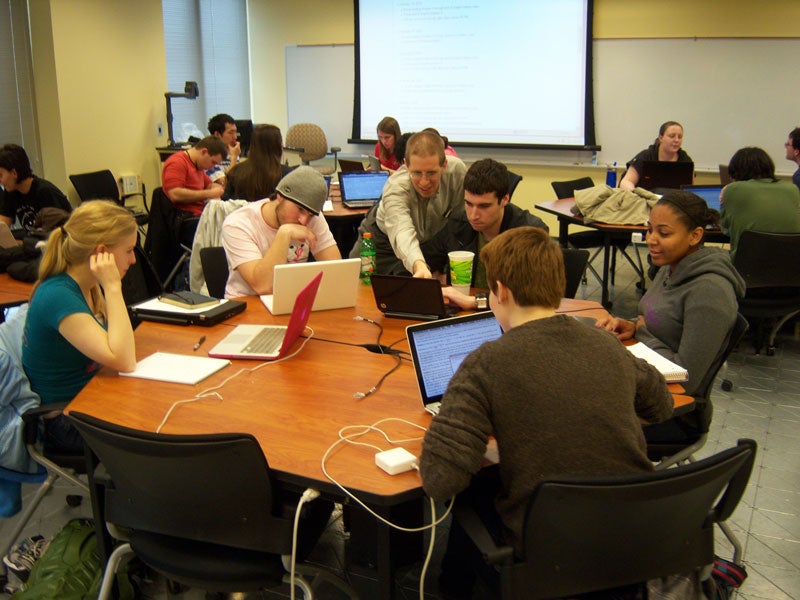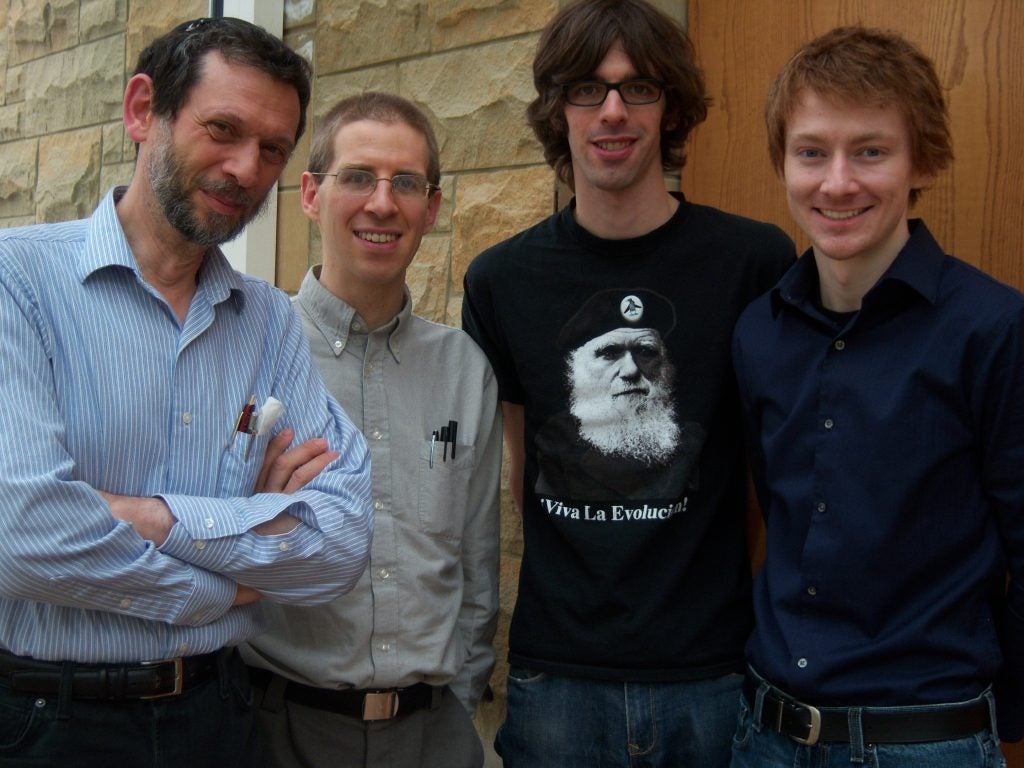 Science magazine has awarded a prize for Inquiry-Based Instruction to a Case Western Reserve University class that melds biology, computer modeling, mathematical analysis and writing.
“Dynamics of Biological Systems,” taught by Biology Professor Hillel Chiel and three graduate assistants, abandons traditional lectures altogether in favor of learning by doing. The teachers call the class an example of the use of the continual improvement model in education.
In it, Chiel pairs biology majors with engineering, physics or math majors and has them concentrate on building academic and collaborative skills as they apply math to biological questions. Teachers provide guidance, not answers, often working one-on-one through class time.
Chiel and doctoral students Jeffery P. Gill, Jeffrey M. McManus and Kendrick M. Shaw describe “Dynamics” and the philosophy behind the course in a recent issue of Science.
The Science Prize for Inquiry-Based Instruction was established to encourage innovation and excellence in education by recognizing outstanding, inquiry-based science and design-based engineering education. Winners are selected by the editors of Science with the assistance of a judging panel composed of teachers and researchers in relevant science and engineering fields.
Each month, Science publishes an essay by a recipient of the award, which explains the winning project. Only 20 percent of submitted entries go on to become winners.
“The vast majority of biologists hate math and usually don’t like programming,” Chiel said. “Many engineers have been forced to take biology and hate it because of the memorization.” The prevalence of these attitudes is reflected in questionnaires the students complete at the beginning of the semester.
This class, however, puts the two disciplines firmly in students’ hands, to explore and build proficiency, and, eventually, to replicate and build on recent math models used in the biological sciences. The course is cross-listed as both a biology and biomedical engineering class.
“I’ve previously taken regular calculus classes with engineers and wondered what would the classes ever be useful for,” said Kate Coyle, a biology major who completed the Dynamics class and graduated this semester. “Labs I’ve had in biology and physics show you the protocol and the expected result.
“This is not the same, at all. We were solving real problems every day.”
Students work through problems using an online interactive textbook, Dynamics of Biological Systems: A Modeling Manual, that Chiel wrote and the computer programming language Mathematica, which scientists worldwide rely on to build mathematical models of complex systems. Chiel’s book is available free to students as well as teachers who may want to use it as is or as a model for their own classes.
When teams become stuck on a problem, Chiel or a teaching assistant makes suggestions, gives clues and tries to coax out the answer. After success, teachers quiz individuals about how they found the solution and what they’d learned.
The class of 30 is spread out among hexagonal tables. Teams power up their laptops and go to work. Each day the teachers rotate to a different group of students, and after each class they compare notes on who has mastered the skills and who needs extra help, Gill said.
Science magazine has awarded a prize for Inquiry-Based Instruction to a Case Western Reserve University class that melds biology, computer modeling, mathematical analysis and writing.
“Dynamics of Biological Systems,” taught by Biology Professor Hillel Chiel and three graduate assistants, abandons traditional lectures altogether in favor of learning by doing. The teachers call the class an example of the use of the continual improvement model in education.
In it, Chiel pairs biology majors with engineering, physics or math majors and has them concentrate on building academic and collaborative skills as they apply math to biological questions. Teachers provide guidance, not answers, often working one-on-one through class time.
Chiel and doctoral students Jeffery P. Gill, Jeffrey M. McManus and Kendrick M. Shaw describe “Dynamics” and the philosophy behind the course in a recent issue of Science.
The Science Prize for Inquiry-Based Instruction was established to encourage innovation and excellence in education by recognizing outstanding, inquiry-based science and design-based engineering education. Winners are selected by the editors of Science with the assistance of a judging panel composed of teachers and researchers in relevant science and engineering fields.
Each month, Science publishes an essay by a recipient of the award, which explains the winning project. Only 20 percent of submitted entries go on to become winners.
“The vast majority of biologists hate math and usually don’t like programming,” Chiel said. “Many engineers have been forced to take biology and hate it because of the memorization.” The prevalence of these attitudes is reflected in questionnaires the students complete at the beginning of the semester.
This class, however, puts the two disciplines firmly in students’ hands, to explore and build proficiency, and, eventually, to replicate and build on recent math models used in the biological sciences. The course is cross-listed as both a biology and biomedical engineering class.
“I’ve previously taken regular calculus classes with engineers and wondered what would the classes ever be useful for,” said Kate Coyle, a biology major who completed the Dynamics class and graduated this semester. “Labs I’ve had in biology and physics show you the protocol and the expected result.
“This is not the same, at all. We were solving real problems every day.”
Students work through problems using an online interactive textbook, Dynamics of Biological Systems: A Modeling Manual, that Chiel wrote and the computer programming language Mathematica, which scientists worldwide rely on to build mathematical models of complex systems. Chiel’s book is available free to students as well as teachers who may want to use it as is or as a model for their own classes.
When teams become stuck on a problem, Chiel or a teaching assistant makes suggestions, gives clues and tries to coax out the answer. After success, teachers quiz individuals about how they found the solution and what they’d learned.
The class of 30 is spread out among hexagonal tables. Teams power up their laptops and go to work. Each day the teachers rotate to a different group of students, and after each class they compare notes on who has mastered the skills and who needs extra help, Gill said.


